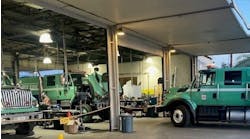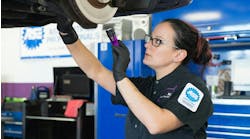A year after Pittsburgh Steelers quarterback Dwayne Haskins was struck and killed by a dump truck while walking across a highway in Fort Lauderdale, Florida, the Broward County law firm representing his family filed a civil suit naming 15 different defendants, including the truck driver, owner of the truck, and trucking company.
Rick Ellsley of The Ellsley Law Firm, who filed the suit on behalf of Haskins’ wife, Kalabrya Haskins, suggested undermaintained brakes and tires contributed to the 24-year-old’s death.
“This truck was going faster than the speed limit, carrying excessive cargo, had brake system problems, and was traveling on low tread tires with separated sidewalls,” noted Ellsley. Ellsley is a native of Columbus, Ohio, where Haskins shone on the field for the Ohio State Buckeyes.
A Level 1 inspection completed of the red 1994 Kenworth T800 truck three days after the incident did reveal brakes and tire issues that would have resulted in out-of-service violations had they been inspected prior to the crash.
Ellsley pointed out that “the [police] report also notes that the driver refused to provide a blood sample to the police at the scene and still has not provided the alcohol test results.”
Read more: Roadcheck 2023 blitz to focus on ABS, cargo securement
This is also true, though police on the scene did not suspect the veteran driver, Oriel Patino, 46, to be intoxicated. Post-mortem blood tests did find high levels of alcohol, along with ketamine, in Haskin’s system. He also violated the Florida statute barring pedestrians from walking on the highway. The Florida Highway Patrol determined Haskins was at-fault for the accident and no criminal charges were filed.
Because it involves a commercial vehicle and a dead NFL quarterback, fleets everywhere should be watching closely how this case plays out. This is the age of nuclear verdicts, after all, where liable trucking companies may be on the hook for multi-million-dollar payouts.
To help educate and protect fleets, here are the facts behind the case, followed by expert-recommended best practices to help fleets prepare for these worst-case scenarios.
The proliferation of nuclear verdicts
A 2020 ATRI report found that between 2010 and 2018, the awards received by plaintiffs in truck-related suits increased from $2.3 million to $22.3 million—about a 1,000% jump. From 2010 to 2019, Florida, Texas, and New York combined to have 575 verdicts over $10 million, according to the U.S. Chamber of Commerce Institute for Legal Reform.
And nuclear verdicts damage the industry as a whole.
"There are other consequences to nuclear verdicts and inflated settlements," explained Alix Miller, president and CEO of the Florida Trucking Association to FleetOwner last year. "They drive up insurance rates, divert money away from increasing companies’ workforce, and can delay purchasing new trucks and safety technologies. Ultimately, this affects everyone: the health of the economy, the supply chain, and cost to transport all of the goods we use."
The fear of these payouts raises insurance premiums and makes it harder for commercial vehicle operators to stay in business. In 2022, lawsuit abuse reform was at the top of fleets' concerns, according to ATRI’s rankings. The American Trucking Associations has taken an aggressive stance in speaking out against nuclear verdicts and advocating for tort reform as well.
The Haskins crash facts
The accident took place on April 9, 2022, at 6:36 a.m. while the 24-year-old Haskins was attempting to cross the westbound lanes of Interstate 595 (State Road 862) in Fort Lauderdale. His rented pickup truck was parked on the northern shoulder of Interstate 95 (State Road 9), a little less than a half-mile west from the crash site where it had run out of gas. Video surveillance from 30 to 40 minutes prior to the accident showed Haskins made it to a 7-Eleven on the south side of State Route 84, one mile from his disabled vehicle. The report noted he was visibly intoxicated and had trouble keeping his balance and filling the gas canister.
A toxicology report from the Broward County Medical Examiner's Office revealed the former NFL first-round pick had a blood alcohol content (BAC) as high as 0.24—three times the legal driving limit in Florida. Haskins had been at four drinking establishments that night, most recently an all-hours nightclub, according to witnesses in the report.
Instead of making it back to the parked rental vehicle, Haskins ended up on I-595, where he was eventually hit by Patino.
The Florida Highway Patrol conducted a Level 1 inspection of the Kenworth T800 on April 12, 2022, and found three out-of-service violations. These included brake systems pressure loss, tire tread and/or sidewall separation, and an audible air leak from the right rear tire. The FHP investigative report noted “because [Patino] did not have time to react and apply the brakes to [the truck], these violations did not contribute to this traffic crash.”
Read more: Wheel-off mock trial demos depth of liability, need for strong maintenance
Law enforcement did not charge Patino, who had driven commercially in the area since 2006 and the 1994 dump truck for the last two or three years. Police at the scene found no signs of Patino being intoxicated. He started his shift at 3 a.m. The Florida Traffic Crash report noted that Patino’s actions did not contribute to the accident. Patino declined the voluntary blood test and told investigators his company would administer one, per their policy. Ellsley said he has not seen these results yet.
The investigation, which included a statement from several witnesses, concluded Haskins himself, along with poor visibility, caused the accident. He was wearing a black shirt and black pants and walked into the center lane at the time and was under the influence of drugs and alcohol.
The highway also lacked streetlights and the sun had not yet risen, which made it difficult for vehicles to see Haskins until the last moment. A few witnesses reported having to swerve to narrowly avoid him. Patino told investigators he saw other cars swerving and upon seeing Haskins in the center lane attempted to do the same. The left-front side of the truck collided with Haskins, who hit the asphalt and slid for 168 feet. Patino told police he was going 55 mph; the speed limit was 65 mph.
A forensics investigation of the engine control module (ECM) could not determine the speed, and the imaging done by Kears Kinetic Engineering and Accident Reconstruction yielded “only generic information and nothing that was specific to this traffic crash,” the report stated.
The civil complaint was dated March 23, 2023, and filed with the Broward County's 17th Judicial Circuit. The suit named Patino, along with truck owners Pedro Diaz and Sorrell Enterprises—which hires owner-operators as drivers—as defendants, along with the Florida Department of Transportation, and the four businesses where Haskins was served alcohol. Haskins’ companions, who Ellsley suggests may have “targeted and drugged [Haskins] as part of a blackmail and robbery conspiracy,” were also named in the suit.
The justification for the suit
After filing the civil suit, Ellsley spoke to Fleet Maintenance to explain why he is pursuing the case.
He stressed that while “overregulation is never a good thing,” the transportation industry needs sensible rules and standards “to help ensure public safety.”
And oftentimes, he says, the public is at risk. “What we see frequently in South Florida are old, undermaintained trucks operated by very small mom-and-pop carriers, brokers, and drivers, that would not know where to even look for safety regulations,” explained Ellsley, who has been practicing civil law for 23 years and is a board-certified specialized lawyer. “I see aggregate trucks going from Port Everglades to Medley on a daily basis that are a complete mess.”
The truck in this case was nearly 30, though many old trucks can still perform their jobs safely. To uncover if the driver or trucking company could—or should—have done anything to prevent Haskins' tragic death, such as provide better maintenance, the civil suit was necessary, Ellsley said.
“Subpoenas will help us get more information about this particular truck and driver, as far as the maintenance records, the alcohol testing, and cell phone records, which we cannot do without a subpoena power provided by a lawsuit,” he said.
Ellsley also said he understands his job puts him at odds with the trucking community, for whom he said he has great respect, but he wants truck operators to consider public safety as a very high priority and also their financial liability before putting any undermaintained truck on the road.
“There is a consequence to putting these vehicles on the road with all these violations,” Ellsley said.
Lessons learned
In this case, despite the plaintiff’s lawyer’s claims, the reports written by law enforcement concluded that no driver was culpable. Still, there is no telling what a jury will decide. Or if the trucking company named will settle to avoid trial.
After a high-profile truck crash in 2014, Walmart is believed to have settled for more than $90 million after one of the retailer’s trucks hit a bus limo carrying actor Tracy Morgan and other passengers. Morgan sustained severe injuries and another passenger, James McNair, was killed. The driver, who was fatigued at the time, pleaded guilty.
Settling doesn’t always follow guilt. In 2020, police did not hold Werner Enterprises’ truck driver responsible in a Texas crash that killed two children, but Werner settled for $150 million. The company stated it was liable for $10 million of that, with insurers covering the rest.
The trucking companies involved are nowhere near as big as Werner, which has 10,000 tractors. According to FMCSA records, truck owner Pedro Diaz has a fleet of seven power units. Sorrel claims to have a fleet of 250 owner-operated dump trucks. Litigating the suit will likely take a lot of time and money, neither of which many fleets can spare.
Patino appeared simply to be in the wrong place at the wrong time, but there are actions fleets can take to protect themselves.
Foremost is ensuring preventive maintenance and pre-trip inspection records are beyond reproach. Even if not at fault, a truck involved in a crash that is found to have maintenance violations opens the door for lawyers to subpoena more records.
Ellsley explained his goal as part of the case is to obtain the trucking company’s safety, maintenance, and training records.
This is now common practice with accident lawyers.
According to defense attorney Rob Moseley, founding partner at Moseley Marcinak Law Group, plaintiff’s lawyers “are willing to work hard to understand the trucking business and willing to try a case.”
They look up FMCSA records and scour through any and all relevant records to seek out negligence and/or malfeasance.
“They try to find things that you would have found if you were doing what they contend you should do,” Moseley explained in a 2020 FleetOwner webinar on nuclear verdicts. “Big verdicts are usually preceded by some sort of conduct, not from the driver, but from the motor carrier management.”
Ellsley said he does “a fair amount of trucking cases” and noted he has been recognized for his ethics and professionalism, and unlike billboard lawyers, does not advertise on billboards, television, or radio, relying on referrals from other lawyers.
Moseley said a trucking company should hope to recognize the opposing lawyer’s face from oversized highway posters. “The best day for you is if you get sued by one of the billboard lawyers because they're likely not going to do the things that need to be done to put you on the ropes,” he said.
Plaintiff’s lawyer Jeff Burns, founding partner of Dollar, Burns & Becker advised that the best defense is to spend the money on safety, which means driver training, spec’ing and properly maintaining adequate brakes and tires, and adding collision mitigation technology.
“If the reason for the failure was [the motor carrier] was putting profits over the safety of the motoring public, the closer I can get to showing malice or indifference to safety and shooting for punitive damages,” Burns said.






